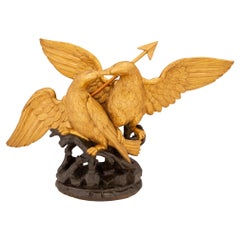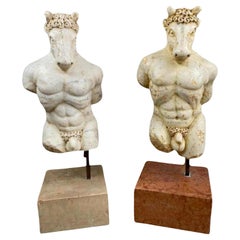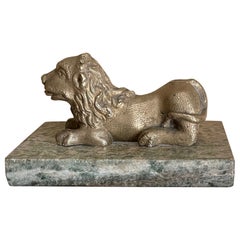Italian Animal Sculptures
35
to
6
18
17
35
35
35
6
2
1
1
35
94
1,576
333
69
868
478
10
2
9
30
22
174
225
255
97
32
Height
to
Width
to
15
15
11
9
4
99
73
60
48
35
3
1
1
1
1
Period: 18th Century and Earlier
Place of Origin: Italian
Italian 18th Century Giltwood and Polychrome Statue of Two Eagles
Located in West Palm Beach, FL
A striking Italian 18th century giltwood and polychrome statue of two eagles. The statue is raised by a most decorative polychrome ground and branch like designed base. Above are two...
Category
18th Century Antique Italian Animal Sculptures
Materials
Giltwood
Pair of Amazing Italians Sculptures "Minotauro" 17th Century Carrara Marble
By Europa Antiques
Located in Madrid, ES
Pair of amazing Italians Minotauro Sculptures
Minotaur, large marble figure,
Italy, 17th century,
figure with a human body and the head of a bull, baroque style, white slightly sp...
Category
17th Century Baroque Antique Italian Animal Sculptures
Materials
Carrara Marble
Rare Pair of Antique Carved Stone Lions from Italy, Circa 1600
Located in Dallas, TX
These utterly captivating, hand-carved stone lions hail from Italy and date to circa 1600, possibly even earlier. Their regal couchant (lying down) posture adds an air of majestic charm to any setting. One lion gracefully rests its forepaws on a stone ball, while the other clutches a coat of arms shield. They are carved in the same stylistic manner as many of the medieval lions...
Category
Early 17th Century Medieval Antique Italian Animal Sculptures
Materials
Stone
Gilt Bronze Lion on Marble Base
Located in New York, NY
Gilt bronze lion on marble base. Antique chased gilt bronze recumbent lion on rare green speckled marble base. Italy, late 17th century.
Dimensions: Ov...
Category
Late 17th Century Baroque Antique Italian Animal Sculptures
Materials
Marble, Bronze, Ormolu
Lion Marble sculpture from the 17th century
Located in Milan, IT
XVII Century
Lion
Marble, 30 x 43 x 25
The object under consideration is configured as a marble sculpture referable to the 17th century, characterized by a strong, visceral langua...
Category
17th Century Antique Italian Animal Sculptures
Materials
Marble
Italian 18th C Grand Tour Roman Bronze Bust of a Horse, Specimen Marble Base
Located in West Palm Beach, FL
Italian 18th C Grand Tour Roman Bronze Bust of a Horse, Specimen Marble Base
Italy, Later 18th Century
A Italian 18th Century Grand Tour Roman Bronze Bust of a Horse, displayed on ...
Category
Late 18th Century Grand Tour Antique Italian Animal Sculptures
Materials
Marble, Bronze
Griffin Head, Italy, 16th Century
Located in Bruxelles, BE
Griffin head
Italy, 16th century
On a modern metal stand
Measures: 20 x 29 x 21 cm (without the stand)
The griffin is a legendary creature with the body of a lion, the head an...
Category
16th Century Renaissance Antique Italian Animal Sculptures
Materials
Marble
Roman Carrara Marble Lioness
Located in Newport Beach, CA
Magnificent hand carved Carrara marble sculpture of a lioness head from Rome. Mounted on a metal base. Base 13.75"W x 12.25"D.
Category
1650s Neoclassical Antique Italian Animal Sculptures
Materials
Carrara Marble, Metal
12th Century Italian Roman Marble Lion
By Europa Antiques
Located in Madrid, ES
Italian Romanesque 12th century marble recumbent lion
12th century Italian roman marble lion
with a stylized mane and tail wrapped around its body a...
Category
15th Century and Earlier Gothic Antique Italian Animal Sculptures
Materials
Stone
Calzetta Da Ravenna Severo Candlestick Depicting a Kneeling Satyr
By Severo Calzetta da Ravenna
Located in Milano, IT
Calzetta Da Ravenna (Attivo Tra IL 1496 E IL 1543 circa) Severo. Circle of. Candlestick depicting a kneeling satyr.
The model of the present bronze is the ""kneeling satyr"" attributed to Severo Calzetta da Ravenna, one of the main Paduan bronze sculptors of the first half of the 16th century, whose figure was rediscovered by Planiscig in 1935 (L. Planiscig, ""Severo da Ravenna...
Category
16th Century Renaissance Antique Italian Animal Sculptures
Materials
Bronze
Rare Pair of Venetian Sitting Mastiffs Dogs
By Venetian School
Located in Bruxelles, BE
Rare pair of sitting Mastiffs dogs.
Venice, end of 15th century - first half of the 16th century.
Istrian stone.
Provenance:
- Important private collection of an architect and scenographer from Orvieto (Umbria)
A regular exportation licence delivered by the Italian Ministry of Culture accompanies the work.
The representation of the dog dates back to ancient times, when dogs were considered weapons of war and used to attack the enemy or stand guard to protect strategic locations. At the entrance to the Pompei’s villa, the presence of a "cave canem...
Category
16th Century Renaissance Antique Italian Animal Sculptures
Materials
Stone
18th Century Italian Giltwood Element Fish Sculpture
Located in Dallas, TX
Unique 18th century giltwood element fish sculpture. This piece includes antique fragments along with a tortoise shell and sea shells. A real conversation piece.
Category
18th Century Antique Italian Animal Sculptures
Materials
Shell, Wood, Tortoise Shell
18th Century Giltwood Element Fish Sculpture
Located in Dallas, TX
Unusual 18th century fish sculpture made of antique giltwood fragments. A very interesting and unique piece of art!
Category
Late 18th Century Antique Italian Animal Sculptures
Materials
Wood
Italian Ancient Marble Sculpture Fountain, Late 16th Century
Located in Milano, IT
Sea monster
Carrara marble mouth fountain
Italy, late 16th century
It measures 13.8 x 31.5 x 18.9 in (35 x 80 x 48 cm)
State of conservation: some small evident gaps and widespread signs of wear due to outdoor exposure. The gray marks crossing it do not come from restoration, but are rather the natural veins of the marble.
This work has some morphological characteristics typically associated with the iconography of the sea monster: an elongated muzzle, sharp teeth, protruding eyes, elongated ears, and a coiled serpent's tail.
An in-depth series of studies on artistic depictions of the sea monster attempted to verify how this symbol evolved in antiquity in the European and Mediterranean contexts and how it gradually changed its image and function over time. The iconography itself is mutable and imaginative and its history is rich with cultural and artistic exchange, as well as the overlapping of ideas. This occurred so much that it is difficult to accurately pinpoint the "types" that satisfactorily represent its various developments.
However, we can try to summarize the main figures, starting from the biblical Leviathan and the marine creature that swallowed Jonah (in the Christian version, this figure was to become a whale or a "big fish", the “ketos mega”, translation of the Hebrew “dag gadol”). Other specimens ranged from the dragons mentioned in the Iliad (which were winged and had legs) to "ketos” (also from Greek mythology), the terrifying being from whose Latinized name (“cetus”) derives the word "cetacean". See J. Boardman, “Very Like a Whale” - Classical Sea Monsters, in Monsters and Demons in the Ancient and Medieval Worlds, in Papers presented in Honor of Edith Porada, Mainz am Rhein 1987, pp. 73-84).
In Italy the monster underwent yet further variations: it can be found in Etruscan art on the front of some sarcophagi representing the companion of souls, while among the Romans we find the “Pistrice” (cited by Plinio in Naturalis Historia PLIN., Nat., II 9, 8 and by Virgilio in Eneide: VERG., Aen., III, 427), which appeared in the shape of a stylized hippocampus or a very large monstrous cetacean and evolved into a hideous being with a dragon's head and long webbed fins.
During the Middle Ages, the sea monster was the object of new transformations: at this time, it is often winged, the head is stretched like a crocodile, the front legs are often very sharp fins - sometimes real paws - until the image merges with dragons, the typical figures of medieval visionary spirituality widely found throughout Europe (on this topic and much more, see: Baltrušaitis, J., Il Medioevo fantastico. Antichità ed esotismi nell’arte gotica, Gli Adelphi 1997).
In Italy during the 15th and 16th centuries, the revival of classicism - representative of the humanistic and Renaissance periods - led to a different reading of these "creatures". Indeed, the sea monster was also to find widespread use as an isolated decorative motif, especially in numerous fountains and sculptures where dolphins or sea monsters were used as a characterizing element linked to water (on this theme see: Chet Van Duzer, Sea Monsters on Medieval and Renaissance Maps, London, The British library, 2013).
From the morphological point of view, the "sea monsters" of this period are mostly depicted as hybrid figures, in which the body of a mythological or real being (a hippocampus, a sea snake, a dolphin), is joined to a head with a rather indistinct appearance. It was usually characterized by large upright ears, an elongated snout, sharp teeth and globular, protruding eyes; a complex and indefinite figure, both from the symbolic point of view and from that of its genesis.
The work we are examining is placed as a cross between the medieval sea serpent and the Renaissance dolphin, with stylistic features which recall the snake as often used in heraldry (such as the "snake" depicted in the coat of arms of the Visconti - the lords and then dukes of Milan between 1277 and 1447 - and which, for some, may be derived from the representations of the “Pistrice” that swallowed Jonah).
In the search for sources, Renaissance cartography and in particular woodcuts should not be neglected. See for example the monsters of Olaus Magnus, from the editions of the “Historia de gentibus septentrionalibus” (“History of the peoples of the north”) and the natural histories of Conrad Gesner, Ulisse...
Category
16th Century Renaissance Antique Italian Animal Sculptures
Materials
Carrara Marble
Cerberus, Italy, 17th Century
Located in Bruxelles, BE
Cerberus
Black painted stone
Italy, 17th century
Measures: 80 x 69 x 36cm
(one head missing)
Cerberus, cruel monster, fierce and strange,
Through his wide threefold throat barks as a dog
Over the multitude immers'd beneath.
His eyes glare crimson, black his unctuous beard,
His belly large, and claw'd the hands, with which
He tears the spirits, flays them, and their limbs
Piecemeal disparts (Dante, Inferno, Canto VI).
Cerberus figure seated, in his role of ferocious guardian of the underworld; he shows a nervous musculature, an adherent skin which reveals the ribs, long and robust limbs; his heads are broad and the eyes set well apart.
Painted in black to amplify his menacing look, the infernal guardian is depicted with his famous attributes, writhing his heads, growling and barking furiously.
Cerberus, in Greek mythology, was the monstrous watchdog of the underworld – also known as the “hound of Hades” – preventing the dead from leaving, and making sure that those who entered never left.
A child of Typhon and Echidna, he was part of a monstrous family, which included Orthus, the Lernaean Hydra, and the Chimaera as well. Only on three occasions Cerberus was tricked by visitors of Hades: Heracles did it with his strength, Orpheus with his music.
In "The Inferno", Dante places Cerberus as the guardian of the third circle of Hell. With his three mouths, Dante saw Cerberus as a beast that was synonymous with the sin of Gluttony. Virgil gets past the monster by throwing mud in his three mouths, temporarily choking him.
Very rare are the representations of Cerberus in ancient statuary...
Category
17th Century Renaissance Antique Italian Animal Sculptures
Materials
Stone
IMPORTANT ITALIAN IMPERIAL EAGLE 17th Century
By Europa Antiques
Located in Madrid, ES
IMPERIAL EAGLE
Italian,
17th Century
sculpture in carved and gilded wood, based on a base decorated with plant motifs and masks with two claw and ball-...
Category
Late 17th Century Baroque Antique Italian Animal Sculptures
Materials
Wood
Antique Baroque Handcarved Lion Sculpture, Italian or Austrian
By Antonio Raggi
Located in Vienna, AT
Early fine carved sculpture of a lying lion. Attributed to the circle of Alessandro Vittoria, located in northern Italy/ Venice. Original late Renaissance or early Baroque figure.
T...
Category
17th Century Baroque Antique Italian Animal Sculptures
Materials
Wood
Large Heavy Rectangular Carved Marble Relief of the Agnus Dei 'Lamb of God'
Located in Guaynabo, PR
This is a large heavy rectangular shaped carved marble relief of the Agnus Dei. It depicts a lamb with curly hair seated over a Bible and bearing ...
Category
18th Century Neoclassical Antique Italian Animal Sculptures
Materials
Marble
Sculpture of a Carrousel Horse, Italy, 1750
Located in Milan, IT
An old Italian wooden sculpture of a rampant carrousel horse. Modern metal base. Measure refers to the horse only. Italy, 1750 ca.
Category
Mid-18th Century Antique Italian Animal Sculptures
Materials
Iron
Pair of 18th Century Italian Carved Fruitwood Polychrome Horses
Located in New York, NY
Each on hind legs one black and one white and a mirror form of the other.
Category
Late 18th Century Antique Italian Animal Sculptures
Materials
Fruitwood
Pair of Italian 18th Century White Carrara Marble Statuettes of Lions
Located in West Palm Beach, FL
A charming true pair of Italian 18th century white carrara marble statuettes of lions. Each statue is raised by an oval terr...
Category
18th Century Antique Italian Animal Sculptures
Materials
Carrara Marble
18th Century Italian Fragment Owl Sculpture
Located in Dallas, TX
18th century Italian sculpture of an owl made of fragments including a sharks jaw. So interesting. A real conversation piece!
Category
18th Century Antique Italian Animal Sculptures
Materials
Other
Pair of 18th Century Italian Water-Gilt Fragment Horse Head Sculptures
By Interi
Located in Dublin, Dalkey
Pair of 18th century Italian gold-leaf fragment horse head sculptures.
The pair is made of 18th century Italian water-gilt fragments mounted on scroll ...
Category
18th Century Rococo Antique Italian Animal Sculptures
Materials
Gold Leaf
Pair of Eagles 16th Century from North Italy Church Lectern
Located in Brussels, Brussels
Exceptional pair of aigles of the 16th century of Italy
Superbe pair of wooden sculpted aigles from the Italian Renaissance. Very Fine and delicate sculpture
The pair of eagles se...
Category
16th Century Renaissance Antique Italian Animal Sculptures
Materials
Giltwood
Lions Pair of Sculpture Marble Italian 13th Century Romanesque
Located in BUNGAY, SUFFOLK
Rare, pair of 13th century, Romanesque, marble, recumbent lions
Recumbent lions were popular in 11th-13th century Italian architecture with pairs ...
Category
15th Century and Earlier Classical Roman Antique Italian Animal Sculptures
Materials
Marble
Pair 18th C. Carved Marble Terracotta Figures Lions Sculptures Garden Statues LA
Located in West Hollywood, CA
Pair 18th C. Carved Marble Terracotta Figures Lions Sculptures Garden Statues LA . Rare large Pair of early 18th century carved marble terracotta Figures of regal lions, holding an i...
Category
Early 18th Century Antique Italian Animal Sculptures
Materials
Stone, Marble
Cavalier King Charles Spaniel Gilt Porcelain Dog
By Giustiniani Family 1
Located in New York, NY
Cavalier King Charles spaniel gilt porcelain dog. Antique gilt porcelain dog sculpture on conforming white oblong octagonal gilt banded ...
Category
Late 18th Century Antique Italian Animal Sculptures
Materials
Porcelain
Italian Baroque Style Carved, Painted and Gilded Wood Figure of a Griffon
Located in Hudson, NY
This large 18th century figure of a dramatic and animated Griffon was made in Italy in the mid-18th century. Carved in great detail then gessoed, painted and gilded the figure stands...
Category
Mid-18th Century Baroque Antique Italian Animal Sculptures
Materials
Wood
Large 17th Century Wood Carved hanging Italian Eagle or Bird of Prey Sculpture
Located in Haarlem, NL
This is a very rare large antique hand carved, polychromed and gilt eagle.
Unbelievable workmanship went into making this wooden bird of prey sculpture...
Category
Early 17th Century Antique Italian Animal Sculptures
Materials
Gold
Spectacular Bronze Sculpture, Italy
Located in Milan, Italy
Sculpture in bronze lost-wax casting,.
Origin from a Como private house in circa 1970.
Category
1670s Modern Antique Italian Animal Sculptures
Materials
Bronze
Pair of Early Giltwood Book Stands Carved as Doves
Located in Houston, TX
Pair of early giltwood book stands carved as doves mounted upon orbs, from the late 17th or early 18th century. Nice large scale. Books are laid open across the backs of the doves' w...
Category
Early 18th Century Baroque Antique Italian Animal Sculptures
Materials
Oak, Giltwood
Vinovo Porcelain Lion Sculpture
By Vinovo Porcelain
Located in New York, NY
Vinovo white soft-paste figure of a recumbent lion on a canted rectangular plinth, Italy, circa 1780. Incised cross and V mark. See similar example in the collection of Palazzo Madam...
Category
Late 18th Century Antique Italian Animal Sculptures
Materials
Porcelain
Pair of Continental Lion and Lioness, Italian, circa 1770
Located in New York, NY
Pair of continental lion and lioness, Italian, circa 1770.
Category
Late 18th Century Antique Italian Animal Sculptures
Materials
Ceramic
Gruppo di scimmie in legno intagliato. Lombardia, seconda metà del XVIII secolo
By Non-Standard Furniture and Lighting
Located in Milano, IT
Gruppo di quattro scimmie in legno di tiglio finemente intagliato e patinato scuro. I primati, rappresentati con dovizia di particolari anatomici, assumono pose singolari che le rend...
Category
1750s Other Antique Italian Animal Sculptures
Materials
Wood
17th Century Carved Giltwood Eagle Bird of Prey Sculpture
Located in Lincoln, GB
Northern Italian, 17th Century Giltwood Eagle
Hand Carved wooden eagle bird of prey
Gilded and painted over Gesso
Eagles symbolise strengt...
Category
17th Century Antique Italian Animal Sculptures
Materials
Wood
Recently Viewed
View AllMore Ways To Browse
Resting Horse Sculpture
Brass Animal Figures
Angel Fish
Vintage Bird Figurines Animals
Murano Glass Sculpture And Nason
Large Black Panthers
Metal Lion Sculpture
Wooden Swan
Eagle Snake
Vintage Brass Owls
Nason Murano Sculpture
Lions And Deer
Parrot Stand
Vintage Greyhound
Walking Lion
Elephant Statue
Mexican Papier
Resting Deer





